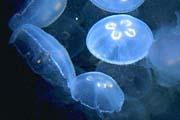
October 2, 2008 - Thursday
![src="http://x.myspace.com/images/spacer.gif"]()
Cnidaria and Porifera
Category: School, College, Greek
Zoology - Lab 2 Phylum:
Cnidaria 
Class:
Hydrozoa Genus:
Obelia Obelia is a dominant polyp, but produces medusa for sexual reproduction. The inner stem like structure is the
coenosarc, a hollow tub composed, like the hydra, epidermis, mesoglea, and gastrodermis. It encloses a gastrovascular cavity that is continuous throughout the colony. The outer transparent covering is the nonliving
perisarc. A transparent extension of the perisarc is the hydrotheca, which forms a protective cup around the
hydranth. Each hydranth has an elevated
hypostome terminating in a
mouth and bearing a circle of
tentacles around the base. Each tentacle has in its epidermis rings of swellings caused by clusters of
cnidocytes, which bear
nematocysts. Food taken by the hydranths can pass it to every part of the colony via the
coenosarc. Reproductive
gonangia are club-shaped and arise at the junction of the hydranth and coenosarcs. Each gonangium is made up of a hollow continuation of the coenosarcs called the
blastostyle. Obelia is found in shallow coastal areas along both coasts of the United States.